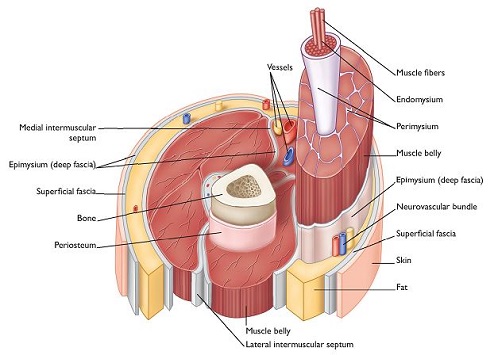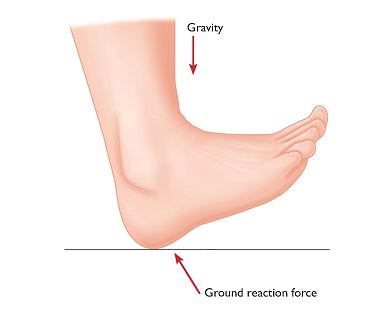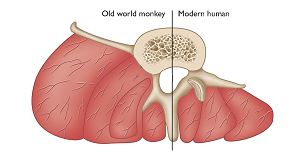Positive Health Online
Your Country

The Functional Anatomy of Walking
listed in anatomy and physiology, originally published in issue 216 - August 2014
The body in a flowing gait is like a well-honed orchestra, each section communicates with the other, rising and falling in harmony with ease and grace, a pleasure to the senses. However, when something is off it creates a cacophony, jarring on the senses and, in the case of the walker, probably jarring on their body.
I have been fascinated by gait over the last few years not just to help analyze clients but also to create a picture of how the whole body co-operates and to map the interrelationships. Through this series of articles we will gradually piece elements together, looking for the common strings. By discussing function, dysfunction and pathology I hope we will come to understand the implications of restrictions on distal areas, why the neck is important for the foot and vice versa.
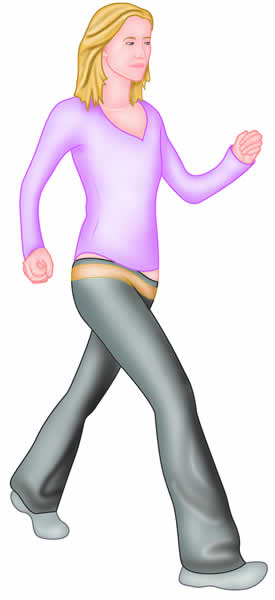
Walking on two legs requires a tremendous act of balance and is often described as ‘controlled falling’ - if we do not successfully put one foot in front of the other, we’ll fall to the ground. For our four-legged friends, walking must be so much easier, as they always have at least two points of contact with the ground at any one time. For us, walking requires the ability to have just one foot on the ground and to maintain some form of equilibrium within our tall, straight, and very unstable structures.
We walk to move around, to take our head and hands to other places, to achieve needs and desires. This apparently simple action requires a brain and nervous system; it demands internal planning and an ability to predict actions and reactions. It makes use of the many other cooperative senses that we have developed over millions of years. For elegant and efficient walking, each of our ‘systems’ - especially those of sight, balance, and sensation - must be communicating in harmony. This requires the coordination abilities of the brain and nervous system.
I believe the whole body walks. That might sound like a ridiculously obvious thing to say, but many schools of thought exist in the modeling of gait that narrow their gaze to analyzing just one aspect of human motion. One of the most widely accepted theories splits the body into ‘locomotor’ and ‘passenger’ sections - the pelvis and lower limbs versus the head, arms, and trunk (Perry and Burnfield 2010). Another school of thought, put forward by Gracovetsky, suggests that we only require the deep spinal muscles to move (2008). The alternate contraction of the multifidi, he argues, gives us the rotational movement we need to propel ourselves in any direction.
While there is certainly a truth in each of these theories, they are - for me - quite incomplete. We use the whole body to walk: the pelvis and legs are assisted by the trunk and the arms. The whole body helps balance and movement by increasing and decreasing the forces moving through the soft tissue. The whole body also works to lessen the amount of distortion that reaches the head. We need to keep our eyes relatively level, and we certainly do not want the force of impact rattling our brains at each heel strike, so we require the trunk and shoulder girdles to constantly adapt to keep the head steady.
The three elements of the walking system I will focus on most will be the fascial, muscular, and skeletal elements. These combine to form a wonderful, symbiotic map of the forces that travel through the body. The shapes and contours of the bones and their joints create pathways, like dry riverbeds, which, come the flood, will direct the water along preferred paths. The bones and joints assist the body through a controlled pattern of shock absorption, with the folding of joints taking place along predictable lines that send the force of impact into the semifluid streams of myofascial tissue.
Our next port of call for this journey through the walking body will be the foot and how it creates a sequence of events in the bones and joints. Understanding the natural inclination of the bones and the way they move on impact will allow us to interpret the role of the soft tissues, which - provided the other systems are properly in place - react to the forces by keeping us upright and still moving forward.
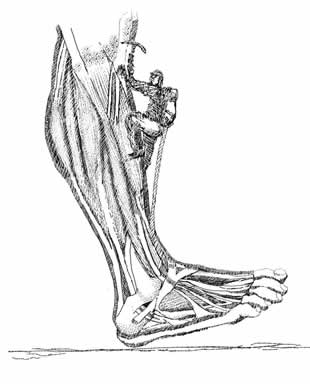
Fig 1: The rapid plantarflexion of the foot stimulates the mechanoreceptors within
the tibialis anterior (amongst many others)
and encourages the contraction to decelerate the movement.
The myofascial tissues are not always consciously directed (as most anatomy books say they are) but are often reactive in behaviour. For example, the tibialis anterior can be actively contracted to create plantarflexion and inversion, but its role in walking is to react to the body’s interaction with the ground to prevent, control, or slow down eversion and dorsiflexion. Its contraction in walking is a response to the lengthening of tissues around it as the foot is planted on the ground - it’s a totally unconscious reaction (see Fig. 1). This reaction is controlled by the proprioceptors in the fascia, and thereby we see the role of the nervous system in this already increasingly complicated story.
Fig 2: The fascial tissue are home to many of the body’s proprioceptors and,
because of its body-wide continuity, can thereby sense and react to distal changes of tension.
The body’s many proprioceptors are constantly sensing changes in tension and relative position and communicating this information to the appropriate muscles. The wonderful work of Huijing has shown us that the mechanical force at a tendon is not communicated only along the muscle itself but is also dispersed into the surrounding fascia and can therefore be felt by the proprioceptors imbedded within neighboring muscles (1999a and 1999b, see Fig. 2). In this way, a change at one end of a muscle can lead to its many neighbors being stimulated, depending on the pattern of movement.
This means that the fascial tissue of tibialis anterior, for example, can perceive mechanical information not only from its neighbors - extensors hallucis and digitorum longus, fibularis longus and brevis - but also from tibialis posterior or any of the other muscles of the leg. It is constantly receiving three-dimensional information of what is happening in the tissue around it and responding to those changes, creating a four-dimensional assessment and reaction to mechanical forces (time being the fourth dimension). The role of the proprioceptors is covered more in later installments.
Fig 3: While gravity has a relatively constant vector ground reaction force can alter depending on the angle
of contact and the angle of the surface. This will then send the forces back
into the body at constantly different vectors and create different affects across the joints.
Underground Forces at Work
‘Ground Reaction Force’ is a vitally important aspect of understanding what is happening during gait. Unfortunately, it is also probably one of the most confused aspects. One of the problems with explaining it is the necessary invocation of physics, and everyone loves to quote Newton’s third law: “To every action there is an equal and opposite reaction.” What this means is that when my foot hits the ground, the ground pushes right back at me with the same force, but in the opposite direction, and this helps keep me upright. Sometimes in movement classes, instructors encourage their students, “push into the ground and feel it push you back up.” Unfortunately, this is a bit of an oversimplification. See Fig 3.
Let us begin with the difference between walking on asphalt and walking on sand - we all know the extra work that is needed when sauntering across a beach. Taking the example of the asphalt first: when we push into it, the surface will deform slightly (not enough for us to notice it with ordinary human senses, but it does happen), and it will return to its original state as we push off from it.
When we walk on the beach, however, the force with which we push into the surface is used to displace the many thousands of grains of sand. The grains are not connected to one another, and so the beach does not have an elastic capability to regain its original form. When we heel strike in sand, most of the force is therefore dispersed and gets lost in the movement of the grains.
If we looked very closely at the sand, we could see that the movement of each grain will depend on its shape and the angle from which it is pushed. Because the grains of sand aren’t bonded together, these changes are similar to hitting balls on a pool table. Once the force stops acting on the grains (or balls), they come to rest where they are, rather than return to their starting position.
Much of the energy inherent in the foot strike was used up by the displacement of the sand. Now imagine that the grains of sand were joined to one another by strong elastic bands. Each of those movements by the sand would be reversible, just like a trampoline, which is temporarily displaced but, due to its elasticity, returns to its original shape - and thereby returns the energy used to displace it by pushing the person who jumped on it into the air.
Until now we have considered the body as a reasonably solid object - when imagining a body jumping on a trampoline, the discussion focused only on stretching of the trampoline alone. But actually the body is also being ‘displaced’ - stretched and moved - when it lands on the trampoline. The skeleton is analogous to the grains of sand, with each bone being moved in a different way through the interaction of gravity, momentum, and ground reaction force. In the human body, however, the bones are held together by elastic tissue, the myofascia, which absorbs the forces coming from each of these three dynamics. This, as you will see, is vital to our understanding of walking, and we must be able to visualize the interactions between the forward momentum of the gait, the downward force of gravity, and the supporting ground reaction forces.
The interaction between the foot and the ground is simple when one is standing still. But in walking, the ground reaction force is not perpendicular to gravity. It is this angle of impact that invokes the folding of the joints throughout the body, and, as we will see as we progress through the book, it is the controlled adjustment of the joints that “loads” the tissue to assist recovery and recoil. (The springs of the trampoline can be seen as an analogy. They are stretched – ‘loaded’ with recoil power - when someone jumps on the trampoline.)
Evolution and Economy
Walking upright is one of the factors that sets us apart from our nonhuman primate cousins and is considered to be one of the main forces behind our evolution into our current Homo sapiens selves. Creating a stable, resilient form with the least calorie usage has been a driving force within nature. Different animals have used different strategies to achieve this equilibrium; evolution is a multifactorial process that cannot be tied down to any one dynamic. Compare the lumbering gait of a rhinoceros to the waddle of the penguin and to the flow of Grace Kelly’s dancing. All are the products of millions of years of evolution on different branches of the tree of life. The rhino has sacrificed grace for strength and a tough hide, allowing it to win most fights in the search for calories. The penguin may look comical on land but is bullet-like in the water, where it meets both its prey and its predators.
Homo sapiens gave up strength and speed and instead aimed for efficiency and generalization. Minimizing our calorie expenditure in the search for food - and maximizing the many strategies we can use to catch, find, or grow it - led to what and where we are now. We made use of many factors inherent in our bodies, especially the potential that was unleashed when we became capable of standing, walking, and running on two legs.
Our brain requires sixteen times more energy than the chemical-to-mechanical-energy-transformers we call ‘muscles’. With 20 percent to 25 percent of our daily resources being diverted to the brain, it makes sense that we take measures to ensure the supply of food to this important organ. The current strategy of the average American is to keep bodily exertion to a minimum - for instance, by walking only 350 intermittent yards per day (McCredie 2007). But this is not a good strategy. Strolling short distances, starting and stopping, takes more muscular effort than sustained walking at a regular pace.
Efficiency is of vital importance for our survival: if we can minimize our calorie output and maximize our intake, we are more likely to survive. Any variation in our anatomy that will enhance that ratio in our favor will be more likely to be passed onto the next generation - it will be favorably selected. As Cochran and Harpending demonstrate in their entertaining text The 10,000 Year Explosion, genetic changes can spread throughout a population surprisingly quickly, with a natural tendency to favour the more effective or positive influences (2010). For example, they argue that the protein dystrophin may have influenced our ratio of muscle to brains and that the changes in this ratio were selected in a relatively short period of time. Around a hundred thousand years ago, we clearly had more muscle and less brain, but in a relatively short space of time, the amount of energy invested in our brains compared to that invested in our muscles became more balanced.
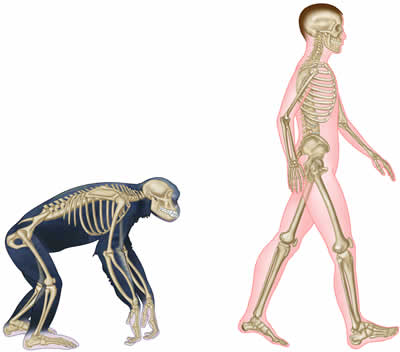
Fig 4: The ability of spinal extension has allowed us to have an upright gait.
As we will see, this means we can
utilize the efficiencies given to us via pretension of long myofascial chains.
Our nonhuman primate cousins have evolved a variety of movement strategies, including the knuckle walking of gorillas and chimpanzees and the four-limbed tree walking of orangutans. Nearly all of them, however, have to use a variation of the bent hip/bent knee posture for movement. This is not due to limitations in length of the hip or knee flexors but rather is caused by a limitation in the lumbar spine, which does not allow for enough extension to bring the pelvis in line with the knees and the feet (see Fig. 4).
Fig 5: With our more vertical alignment to gravity our erectors do not have to
work so hard to keep us upright. In the primate’s forward leaning
posture seen in fig. 4 the back muscles have to work hard to keep the head
upright. This factor is rarely considered when asking ‘why do we walk
on two legs?’ – we do so because it is often more efficient.
One effect of the upright stance has been to greatly reduce the size of the spinal erectors, which are in almost constant use in the forward-leaning posture of the other hominids (see Fig. 5). The cost, however, has been to place the lumbars in a more unstable position, prone to spondylolisthesis and scoliosis (Lovejoy, in Vleeming et al 2007). At first, this may not have been a costly adaptation, as hunter-gatherers may not have lived long enough for these degenerative issues to develop as often as they do today.
Another important skeletal change in our progression to bipedalism was to bring the ilia into a more lateral orientation. This allows the hip abductors to stabilize the pelvis - in other words, the hip abductors stop us from falling sideways when we stand on one leg (remember, we are on one foot during 80 percent of walking). In all other primates, the ilia face posteriorly, and their hip abductors, especially gluteus maximus and medius, function more as extensors (to push them forward) and give little contribution to lateral stability. This means that they are less able to stand on one leg, an essential part of bipedal gait.
Much debate exists about what makes us ‘human’ - intelligence, language, cooperation, society, opposable thumbs, and so forth - but many people believe bipedalism was the main mechanism for accelerating our evolution as a race. It freed our hands to manipulate tools and to communicate with gesture. Our comparative muscular weakness and our long period of immaturity in childhood demanded better communication, as well as protection and cooperation in group activities, such as hunting. According to Richard Wrangham, the freedom afforded to our hands through our ability to remain upright allowed us to control fire, giving us the unique ability to cook (2009). The preliminary breakdown of food in cooking increases the availability of calories, as less energy is required during digestion. Therefore, we absorb more fuel from the food we eat, making it easier to feed the resource-demanding brain.
The truth is that there is no one factor that led to us becoming human, but the common factor in most of the theories is that we developed strategies to become more efficient. The changes that occurred within our body mechanics permit a high degree of efficiency, which, as Bramble and Lieberman have shown, allowed us to become persistence hunters, chasing our prey to death (2004). In addition, we were able to take advantage of our reduced stomach size (due to cooking our food?), our enhanced thermoregulation (we sweat more than other animals), our greater breathing capacity, and, last but not least, our elastic fascial efficiency.
The changes that occurred in our skeletal alignment allowed us to use gravity and ground reaction forces to great advantage, giving us a more efficient interaction between our anatomy and the forces around it. We see this when we compare the penguin’s waddle and an elegant human gait. We don’t always recognize the mechanics involved in those differences though, and this will be the further focus of this series: the synergetic alignment of joints, forces and tissue.
The eccentric lengthening of the tissue that is created by the need for shock absorption also helps the body return in the opposite direction, just like the springs of the trampoline. The myofascia is mechanically loaded, like springs, through the momentum created by the forward and rotational forces of walking, as well as by the pull of gravity. This is performed through relatively passive mechanisms (rather than through muscle contraction) that allow the elastic fascial tissue to be put under stretch in all three planes of motion. Due to the angles and positions of the joints in the body, these forces are not restricted to single muscles - they pass through long, continuous chains of myofascia, most often following the lines of Anatomy Trains, as put forward by Thomas Myers (2009).
By incorporating lines of myofascia the body can capture some of the kinetic energy that is produce through the momentum created in every direction – forward through propulsion, downward through gravity and ‘upward’ via ground reaction force.
References
Bramble, D.M., and D.E. Lieberman. “Endurance Running and the Evolution of Homo.” Nature 432: 345-52. 2004.
Cochran, Gregory and Henry Harpending. The 10.000 Year Explosion: How Civilisation Accelerated Human Evolution. New York: Basic Books. 2010.
Gracovetsky, S. The Spinal Engine. Montréal; Serge Gracovetsky, PhD; 2008.
Huijing, P.A. 1999a. “Muscle as a Collagen Fiber Reinforced Composite Material: Force Transmission in Muscle and Whole Limbs.” Journal of Biomechanics 32 (4): 329-345. 1999.
_______. 1999b. “Muscle Force Transmission: A unified, Dual or Multiple System? A Review and some Explorative Experimental Results.” Archives of Physiology and Biochemistry 170 (4): 292-311. 1999.
McCredie S. Balance: In Search of the Lost Sense. New York; Little, Brown and Company. 2007.
Myers TW. Anatomy Trains: Myofascial Meridans for Manual and Movement Therapists. Edinburgh UK: Churchill Livingstone Elsevier. 2009.
Perry, J., Burnfield, J.M. Gait Analysis. New Jersey; Slack Inc.; 2010.
Vleeming, A., Mooney, V., and Stoeckart, R. (eds) Movement, Stability & Lumbopelvic Pain: Integration of Research and Therapy. Edinburgh; Elsevier; 2007.
Wrangham, R. Catching Fire: How Cooking Made Us Human. London; Profile Books Ltd; 2009.
Comments:
-
No Article Comments available
